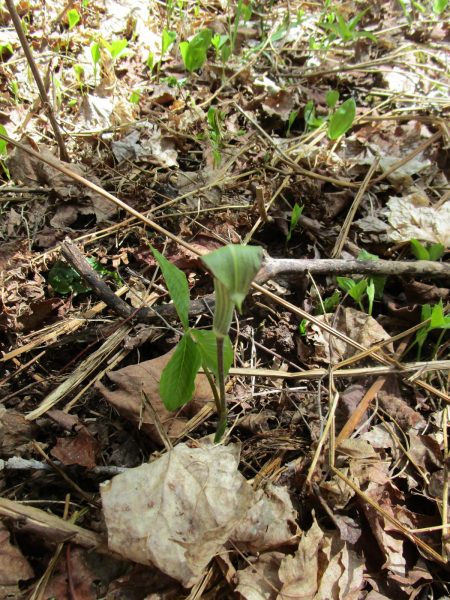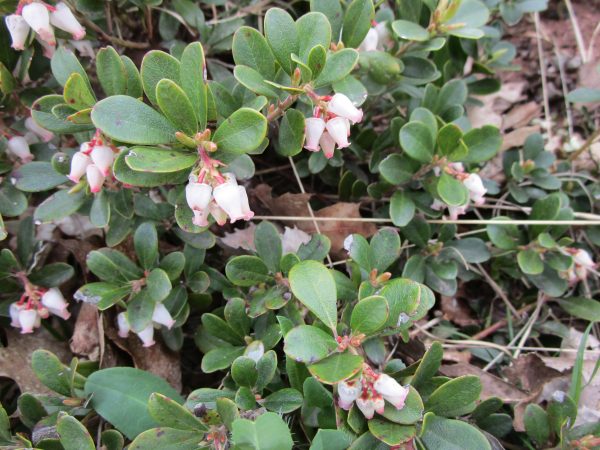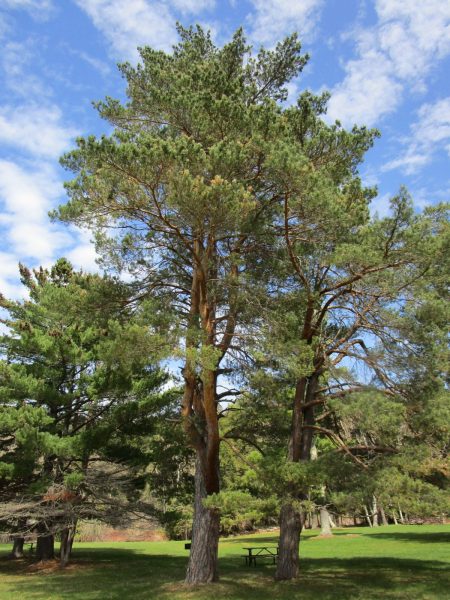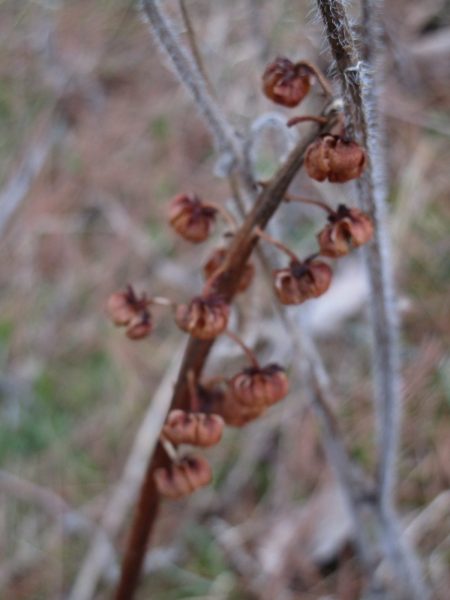I’ve already been here for a month? That’s amazing!
Hello! Rachael here.
It seems like everything is blooming a little later this year, which has been both frustrating and quite useful for catching up. The data on rare plants is usually accompanied by a field log, where the intern or employee explains the environment they are in, emphasizing the rare plants and those either competing or coexisting nearby, as well as what is in flower. That’s been helpful for learning the area.
Many rare plants are not so unique that they can be identified without the flower. For example, Erythronium, or the trout lily genus are abundant in the park and state of Maryland, but the white trout lilies are listed as S2.
Here is an Erythronium species leaf, and then a flowering Erythronium americanum found at a different location.

Erythronium species leaf

Erythronium americanum
These have just started flowering. The rare white trout lilies should also flower soon.
I enjoy being able to visit so many sites within the park, but revisiting them at a later point in the season is an added experience. A few weeks ago, the few plants out of the ground were bloodroot (Sanguinaria canadensis) and hepatica (Anemone americana). Because of the leaf shape, A. americana is one of my favorites. They are so cute and simple (I don’t think my photo does it justice, though…)

Anemone americana
There was still snow then. It was cold, beautiful, and I had no idea what I could have been stepping on. Needless to say, not much useful data was recorded.
The next time I visited the same site, Dirca palustris, commonly known as leatherwood, was in flower. This shrub is super flexible, and the coloring of the stems is lighter. It’s a unique plant that’s pretty hard to miss, especially if it’s reaching onto the trail (it grabbed my face on an incline) with those little flowers.

Dirca palustris in flower
But back to challenges, because what fun would it be to have every rare plant clearly identifiable from the trail?
A lot of my time in the office is either spent figuring the best way to visit a site (at the best time) and updating myself on how to differentiate between rockcress. The kicker here is that some of the rockresses that used to be Arabis are now Boechera or Arabidopsis, and it seems the rare plant community accepts the synonyms (or maybe I’m under the wrong impression).
But aside from having multiple names and multiple species, rockcresses aren’t easy to differentiate unless they are a little more developed than the ones I’ve included in photos here. The basal and cauline leaves have characteristics that separate the species, but are variable and rather similar to each other. In order to tell them apart for an accurate identification, I’ll wait for flowers and fruits. That should be soon if not sometime this week!

Arabis? Boechera? Too soon to tell! –And is that Micranthes on the left?
Anyway, I am feeling a little better now about the whole Arabis/Boechera struggle after consulting both the regional and Maryland botanist about it. They also gave me some career advice, and asked me what I’d like to do. My answer is usually “eventually I’ll get to grad school, but I want to explore my options and work outside for as long as I can. Let’s look at some plants!”
A man (park volunteer?) came up to me while I was working the other day, explaining how picking up trash was good exercise (he was about to pull a tire from the river). After loading five or so trash bags full of beer cans, wine bottles, silver-side-out chip bags, muddy shoes, etc… into his car, he found out I was a wanna-be botanist, and he posed an ID question: it’s got these shiny sort-of leaves (makes hand motion like rubbing dimes together) and alien-like flowers. White at the top, yellow beak, bizarre thing, really, those flowers.
I told him I couldn’t match anything to that description. Alright, he pulled some (please don’t pull plants! You can’t have those.) out of his car. It was a rather car-heat-stroke looking Dicentra cucullaria. Dutchman’s breeches! What a name. They are flowering all over the place.

Dutchmans breeches
Speaking of native plants, my last post featured Mertensia virginica, but these are in flower. I sent a pic home saying they reminded me of Mom, and the response asked if they have thorns. *sigh* I was trying to be nice…

Virginia bluebells
Last week, another intern (through a different program) came along for a day out in the field. We drove down to a pretty popular trail (after hanging some signs for a rabid raccoon)(at the site where the man was picking up trash and Dutchman’s breeches). This section of the Billy Goat Trail is definitely a cool area. It transitions from rocky outcroppings to sandy riparian beach to swampy to forest within a mile or so. Because of this and its proximity to highly populated areas, the plants are pretty diverse. The downside is the constant threat of invasive plants and the risk of rare plants being trampled.
We spotted flowers (finally!) and rare plants along the trail, so I’ll have to get back to explore the whole area.

Stellaria pubera–giant chickweed, stitchwort

Phlox subulata–moss phlox
I am having a great time, and interacting with others reminds me why I wanted to be here: to learn and to serve, basically. I have the opportunity to work outside as much as I want and understand how to better protect the environment and history through the vegetation. That’s my job. Plant protector (in a way) in Chesapeake and Ohio Canal National Historical Park; that’s my internship.
I came across a great couple of lines the other day from Gwendolyn Brooks’ “An Aspect of Love, Alive in the Ice and Fire” dedicated to LaBoehm Brown:
“You rise. Although / genial, you are in yourself again.”

The Potomac, still, across from where I am staying.
Still can’t believe we’ve been more than halfway through April all day…
Rachael





































